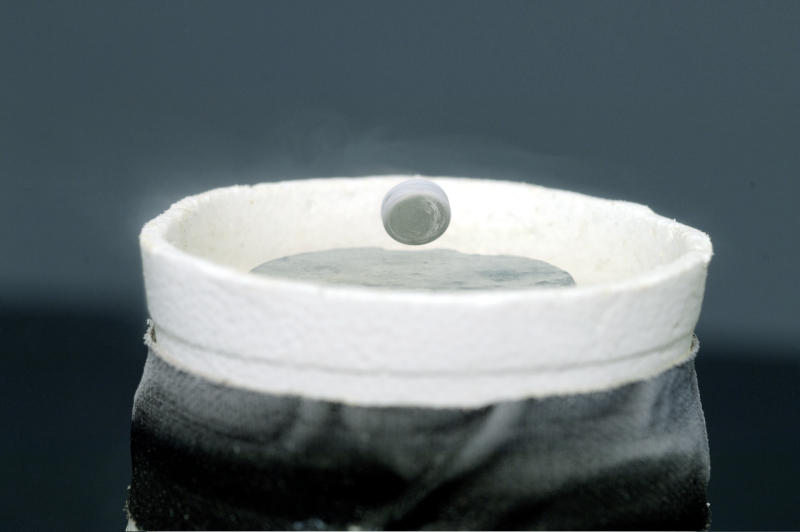What it shows:
A superconducting material in the presence of an external magnetic field excludes that field from its interior. This is shown by levitating a magnet above a high-temperature superconductor.

Photo courtesy Clive Grainger
How it works:
We have a 25mm disc of ceramic yttrium barium copper oxide (YBa2Cu3O7, also commonly referred to as "YBCO") that becomes superconducting above liquid nitrogen temperatures (Tc = 90K). Using a cubic neodymium magnet (4mm per side, 0.5 grams), two effects can be shown. Firstly, the Meissner effect itself, by placing the magnet on the disc before cooling. As the disc cools past its transition temperature, it expels the external magnetic flux and the magnet begins to levitate. Alternatively, cool the disc so that it becomes superconducting, then introduce the magnet. The external flux sets up a circuital persistent current in the superconductor, whose own field repels the magnet—the result again is the magnet bobbing a few mm above the surface of the disc. (In both cases the details of the interaction between the magnet and superconductor are complicated and cannot be fully explained by classical physics.)
Check out this video of the demo in action.
Setting it up:
The superconducting disc sits in the bottom 5mm segment of a Styrofoam cup, which itself rests on a whole inverted cup; this is well insulated as well as providing a white backdrop for the YBCO disc and the neodymium magnet. Place the magnet on the disc. The YBCO and the magnet should only be handled with tweezers. Use a camera with a macro lens to compose a shot of the interior of the cup. Slowly pour the liquid nitrogen into the cup so that it barely immerses the disk; the YBCO will transition suddenly to superconducting after about 10-15 seconds, at which time the magnet will rise about 7mm above the disc.
Comments:
This is a commercially available ceramic superconductor.1 Sergent-Welch and Cenco also sell kits.
References:
Meissner, R.W., Ochsenfeld, R., Naturwissenschaften 21, p.787 (1933)
Purcell, Edward and David Morin. Electricity and Magnetism, Third Edition. New York: Cambridge University Press, 2013. Print.
Tinkham, Michael. Introduction to Superconductivity, Second Edition. Mineola: Dover Publications, 2004. Print.
1 Colorado Superconductor Inc., P.O. Box 8223, Fort Collins, Colorado 80526
